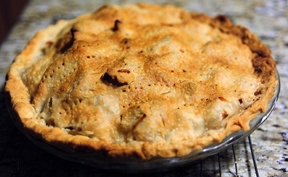- Author: Kathy Keatley Garvey

It causes a stampede to the dining room table, that's what it does. Expect to see chairs overturning, plates flying and forks spinning.
That's because Gravensteins make the best pies. As any apple pie aficionado will tell you: the best pies are the "G" pies: Gravenstein (first) and Granny Smith (second).
The Gravenstein apple reigned as the preferred apple on our family farm in western Washington. We found the sweet-tart apple "perfect" for eating right off the tree, or made into pies, applesauce and apple cider. The cows liked them, too. A gentle nudge on the tree, and - eureka! - apples would magically fall to the ground. Talk about happy cows!
This heirloom apple also reigns supreme in Sonoma County. Just ask the Gravenstein apple farmers, area residents, restaurants and the tourists who line up to buy a bag or two.
That's because of its flavor, its propensity for being in the right place (pie) at the right time, and its short season make it even more treasured. Plus, this is an apple with an aroma. The delightful fragrance will permeate your kitchen.
It's a short, squatty looking apple, streaked with red. Sometimes Nature's paintbrush turns the thin streaks into thick bands. And the stems are short - so short and so susceptible to falling from the tree that, "growers estimate they lose 40 percent of their apples even before they are ripe," wrote Carolyn Jung of The Day newspaper, New London, Conn., in her interview with Paul Vossen, UC Cooperative Extension advisor in Sonoma and Marin counties, for a Sept. 8, 1999, article.
First described in 1797, the Gravenstein originates from Denmark, where it's known as "Gråsten." It took a couple of centuries to do it, but in 2005, Denmark declared it the "national apple."
How did it get to Sonoma County? Russian trappers first planted it there in 1811. The good citizens of Sonoma so liked the apple that they named a major artery the "Gravenstein Highway." Over the last six decades, however, "Sonoma County's Gravenstein orchards have declined by almost 7,000 acres and are currently down to 960 acres," according to an article on the Slow Food USA website.
Why? Farmers find it more profitable to grow grapes.
Also, it's not an easy apple to market. It's an early variety with a very short season, usually during a few weeks in August. Blink and it's gone.
And, it's an apple you won't find in your local produce section, tucked among the Red Delicious, Galas, Fujis, Pink Ladies and Granny Smiths.
"They don't travel well, and they don't last long (short season)," says Daniel Sumner, professor in the Department of Agricultural and Resource Economics at UC Davis and director of the UC Agricultural Issues Center. "To consumers, this is the kiss of death."
Enter the Slow Food movement. To help preserve the heirloom apple, the Russian River Slow Food group contacted area restaurants and asked that it be featured in their desserts. Getting into the preserve-the-Gravenstein act, the FruitGuys, a company that ships organic fruit to customers, donated 17 percent of this year's proceeds back to the Gravenstien apple farmers.
Every little bit helps.
In the meantime, Sebastopol continues to celebrate its annual Gravenstein Fair; this year the event took place Aug. 11-12.
In search of Gravensteins, we drove to Sebastopol on Sunday, Aug. 19, just as the season was about to end. "Ours will be gone in a couple of days," a farmer told us.
"Which apple makes the best pie?" we asked. "Granny Smiths or Gravensteins?
"Gravensteins," the farmer said. "Hands down."
We agree.
Here's our family recipe for Gravenstein apple pie. We favor using brown sugar instead of granulated white sugar. And we mix the brown sugar with cinnamon and nutmeg.
Crust for 9.5-inch pie
2 cups flour
1/2 teaspoon baking powder
2/3 cup butter-flavored Crisco, chilled
3/4 teaspoon salt
6 tablespoons water, cold
Sift flour, baking powder and salt. Mix in Crisco until the dough pieces are pea-sized. Add cold water as needed, 6 tablespoons or more, and form into a ball. Roll out dough into a circular shape and invert on pie pan.
Filling for 9.5-inch pie
8 cups of apples, peeled, cored and sliced
1 teaspoon cinnamon
1/2 teaspoon nutmeg
3/4 cup loosely packed brown sugar
1-1/2 tablespoons of butter
Preheat oven to 425 degrees. Gently mix together (with fork) brown sugar, cinnamon and nutmeg and then mix lightly through the apples. Before pouring the mixture into the pie pan, sprinkle a little cinnamon (less than 1/4 teaspoon) on the lower crust. Dot the heaping apple mixture with thin slices of butter. Place top crust on pie. Slit with sharp knife in several places and poke with prongs of fork. Sprinkle a dash of nutmeg on the crust. Line the edge with 1/2-inch strip of aluminum foil to prevent excessive browning. Bake at 425 degrees about 50 minutes or until the crust is lightly browned and the apples are cooked through. Test with fork.
Warning: the aroma of this pie will attract all the neighbors, their families, their friends and their friends' friends.
No wonder Luther Burbank said that “if the Gravenstein could be had throughout the year, no other apple need be grown.”





